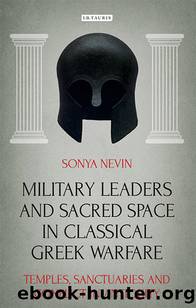Military Leaders and Sacred Space in Classical Greek Warfare by Sonya Nevin;

Author:Sonya Nevin;
Language: eng
Format: epub
ISBN: 9781786720672
Publisher: Bloomsbury UK
The Argives were intent on increasing their influence and the Mycenaeansâ resistance came, in part, through the assertion of control over these sanctuaries. Unfortunately for the Mycenaeans, the Argives counted on the Lacedaemonians being too busy to intervene, and the Argives were proved right. The Mycenaeans were besieged, then enslaved (Diod. Sic. 11.64.3â4).10 Cleonae had always run the Nemean Games (so Pind. Nem. 10.42; 4.17). It seems strange that the Mycenaeans staked a claim. Competing foundation stories gave them grounds.11 That Cleonae joined Argos in the destruction of Mycenae seems to underlie the significance of the sanctuary in the struggle.12 This was a period of region-wide turmoil leading towards the First Peloponnesian War. Corinth appears to have been leading a campaign of expansion, including an attack on Cleonae that must have been a bid to wrest the sanctuary from them â indirectly from rival Argos (Plut. Cim. 17.2). The Mycenaeans had been asserting their independence from Argos for some time; Corinth surely encouraged them to bid for the games as part of a process of diminishing the Argivesâ prestige. Corinth did not prevent the destruction of Mycenae, but fought Argos hard in the coming years of the First Peloponnesian War.13
Meanwhile, further north, struggles for influence at Delphi continued. Epigraphic evidence of an Athenian alliance with the Amphictyony shows Athensâ ongoing interest. Influence at Delphi also underlies the Spartansâ campaign of 458, protecting Doris from Phocian expansion, as it was only through Doris that Sparta had influence on the Amphictyonic Council (Thuc. 1.107.2).14 The Athenians lost to Sparta at Tanagra following the Doris campaign, though they rallied, seized Boeotia, and allied with Sparta's enemies, the Phocians (Thuc. 1.108; 111). Ten years later, the same concerns about influence at Delphi saw the outbreak of the Second Sacred War, with Sparta removing the Phocians from the administration of Delphi and the Athenians marching to put the Phocians back in. The Delphians were also Phocian, but their position at Delphi allowed them to act independently of the other Phocians. These other Phocians lived in the rest of the Phocis region and at the town of Phocis. They do not seem to have had a history of administering Delphi, but their recurrent claim to the role (made primarily on the basis that Delphi was in Phocian territory) was occasionally supported by other parties, destabilising the Amphictyony and the region.15 Thucydides reports:
After this the Lacedaemonians marched out on a sacred war, and becoming masters of the temple at Delphi, placed it in the hands of the Delphians. Immediately after their retreat, the Athenians marched out, became masters of the temple, and placed it in the hands of the Phocians.
(Thuc. 1.112.5)
Download
This site does not store any files on its server. We only index and link to content provided by other sites. Please contact the content providers to delete copyright contents if any and email us, we'll remove relevant links or contents immediately.
Kathy Andrews Collection by Kathy Andrews(11325)
The remains of the day by Kazuo Ishiguro(8395)
Paper Towns by Green John(4800)
Spare by Prince Harry The Duke of Sussex(4788)
Industrial Automation from Scratch: A hands-on guide to using sensors, actuators, PLCs, HMIs, and SCADA to automate industrial processes by Olushola Akande(4604)
The Body: A Guide for Occupants by Bill Bryson(4585)
Be in a Treehouse by Pete Nelson(3648)
Machine Learning at Scale with H2O by Gregory Keys | David Whiting(3627)
Harry Potter and the Goblet Of Fire by J.K. Rowling(3609)
Never by Ken Follett(3528)
Goodbye Paradise(3446)
The Remains of the Day by Kazuo Ishiguro(3139)
Into Thin Air by Jon Krakauer(3131)
The Cellar by Natasha Preston(3077)
The Genius of Japanese Carpentry by Azby Brown(3040)
Fairy Tale by Stephen King(2949)
120 Days of Sodom by Marquis de Sade(2941)
Drawing Shortcuts: Developing Quick Drawing Skills Using Today's Technology by Leggitt Jim(2940)
The Man Who Died Twice by Richard Osman(2808)
